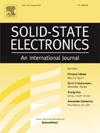用于神经形态计算电路的纳米片场效应晶体管的高效温度相关紧凑模型
IF 1.4
4区 物理与天体物理
Q3 ENGINEERING, ELECTRICAL & ELECTRONIC
引用次数: 0
摘要
在这项工作中,提出了一个温度依赖的紧凑模型,用于三片(3S)纳米片(NS)场效应管。由于大规模电路设计需要一个计算效率高的模型,所以开发了这个模型。该模型基于虚拟源原理,选择虚拟源原理是因为其数学公式简单,参数要求最小。这使得该模型能够准确地捕捉到3S NSFET的性能特征。利用TCAD结果对模型进行了验证,并与实验数据进行了很好的校正。然后在Verilog-A代码中实现神经形态电路模拟。在此,我们分析了基于nsfet的LIF神经元在温度变化下的功率、能量和峰值频率等重要参数。结果表明,当温度从25℃升高到125℃时,由于器件亚阈值工作电流增大,峰值频率增加了36.64%。本文章由计算机程序翻译,如有差异,请以英文原文为准。
An efficient temperature dependent compact model for nanosheet FET for neuromorphic computing circuit
In this work, a temperature-dependent compact model is proposed for the three-sheet (3S) Nanosheet (NS) FET. This model is developed because a computationally efficient model is needed for large-scale circuit design. The model is based on the virtual source (VS) principle, which is chosen because for its simple mathematical formulation and minimal parameter requirements. This allows the model to accurately capture the performance characteristics of the 3S NSFET. The model is validated using TCAD results, which are well-calibrated with experimental data. It is then implemented in Verilog-A code for neuromorphic circuit simulations. Herein, we analyses the important parameters such as power, energy, and spiking frequency in NSFET-based leaky integrate-and-fire (LIF) neurons, with temperature variations. The results show that as the temperature increased from 25 °C to 125 °C, the spiking frequency increased by 36.64 %, due to higher current in the subthreshold operation of the device.
求助全文
通过发布文献求助,成功后即可免费获取论文全文。
去求助
来源期刊

Solid-state Electronics
物理-工程:电子与电气
CiteScore
3.00
自引率
5.90%
发文量
212
审稿时长
3 months
期刊介绍:
It is the aim of this journal to bring together in one publication outstanding papers reporting new and original work in the following areas: (1) applications of solid-state physics and technology to electronics and optoelectronics, including theory and device design; (2) optical, electrical, morphological characterization techniques and parameter extraction of devices; (3) fabrication of semiconductor devices, and also device-related materials growth, measurement and evaluation; (4) the physics and modeling of submicron and nanoscale microelectronic and optoelectronic devices, including processing, measurement, and performance evaluation; (5) applications of numerical methods to the modeling and simulation of solid-state devices and processes; and (6) nanoscale electronic and optoelectronic devices, photovoltaics, sensors, and MEMS based on semiconductor and alternative electronic materials; (7) synthesis and electrooptical properties of materials for novel devices.
 求助内容:
求助内容: 应助结果提醒方式:
应助结果提醒方式:


